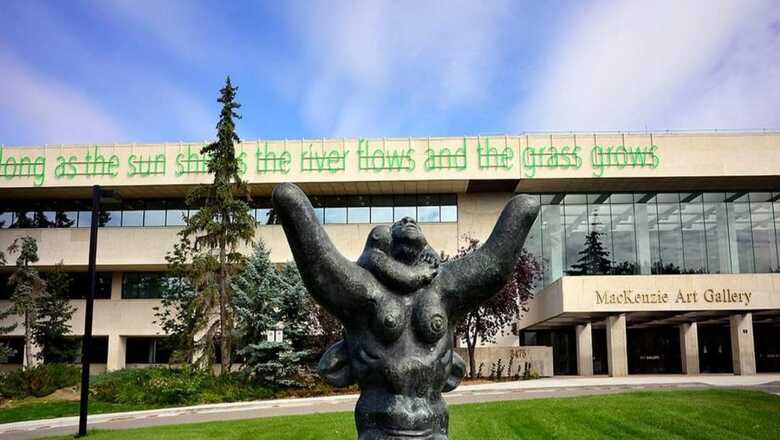
views
We know Canada is slightly confused about gender, as it is about many things. The University of Regina (a public university in Saskatchewan) has a Mackenzie Art Gallery, but the link with the university is no longer as direct as it was in the past. Every Canadian museum now espouses the cause of indigenous art, though Canada, in common with some other countries that espouse human rights, has a dubious historical record of assimilating and civilising First Nations, sometimes still referred to as Indians.
Mackenzie not only has a collection of their Indian art, it possesses a collection of our Indian art too. It inherited this collection (around 400 objects) from the collector Norman Mackenzie (1869-1936). Norman Mackenzie travelled the world in 1912 and 1913, collecting. There is credible evidence, not credible allegation, that this wasn’t always done ethically. The collector circuit gossiped about a trip he made to Kashi in 1913, when he eyed three statues from a functioning temple. His bribery attempts were successful with one and he stole it. That ended up in Mackenzie Art Gallery, labelled as a Vishnu statue. A Vishnu sculpture holding a bowl of rice is unusual, which is why I made that remark about gender confusion. A bowl of rice is standard iconography for Annapurna.
We come to artist Divya Mehra (based in Winnipeg), who went through the Mackenzie collection and identified the statue as Annapurna, stolen from that temple in Kashi in 1913. Later, she held an exhibition in Mackenzie, titled “From India to Canada and Back to India”. This is a reference to the statue being returned to India (and Kashi) in 2021. Since Narendra Modi became PM in 2014, there have been many visible returns of stolen art objects.
Indeed, there are our own internal problems, documented in a 2013 CAG report and S Vijay Kumar’s book on the exploits of Subhash Kapoor, the idol thief now arrested (the book is titled The Idol Thief). There is Meenakshi Jain’s book (Flight of Deities: A Tale of Dharmic Resistance) and the Indica anthology inspirited by that book (The Flight of Deities: An Anthology of Desecration and Devotion, curated by Avatans Kumar). The 2013 CAG performance report is a sad commentary on the preservation and conservation of monuments and antiquities and led to several red faces in ASI (Archaeological Survey of India). That internal laxity may make cross-border theft easier, but it doesn’t condone it. In the 1970s, through UNESCO and outside it, there has been some tightening on theft, looting and illicit trafficking of cultural property. There is also a 1970 Convention, to which Canada is a signatory, having ratified it in 1978. Canada also passed a Cultural Property Export and Import Act in 1985.
Let me quote from a report on Canada’s implementation of the 1970 Convention, submitted to UNESCO in 2012. “Two examples of attempted recoveries of cultural materials under the Canadian Act occurred relatively early in the history of the Act and, in both attempts, it could not be established that the cultural materials had left their country of origin after the date on which the Canadian Act went into effect. One example involved a shipment of antiquities from Egypt that was seized at Mirabel Airport near Montreal in 1989. The Egyptian authorities presented evidence that the artefacts had been illegally excavated and smuggled out of Egypt but, in the end, were not able to present proof that they had been taken out of Egypt after 1978. A similar episode occurred in the prosecution of a dealer for importing artefacts smuggled out of Nigeria.”
But Canada did return (to Peru) antiquities smuggled out in 1985. Other countries have returned historical loot. However, Canada’s official position is abundantly clear. Any loot and scoot done before 1978 is acceptable, under the law. How was Annapurna returned? There is government-driven extradition of stolen artefacts, impossible for anything pre-1978. And there is voluntary return, shame-faced museums do voluntarily.
Morally, if not legally, every museum should establish the provenance, and ownership history of an item it possesses. On social media, Vijay Kumar has recently highlighted the case of Glenbow Museum, based in Calgary. This was built over the years, starting with the private collection of Eric Lafferty Harvie. Glenbow Museum has artefacts not only from native North America, but also from elsewhere in the world — Africa, Asia, Latin America and Oceania. There are 80 statues and sculptures (Hindu and Buddhist) in the collection “Many Faces, Many Paths: Art of Asia”, an exhibition that has now closed. Glenbow got these as donations from the collection of Bumper Development Corporation (BDC).
Although the exhibition has closed, there are images floating around on the Net. For instance, as part of that exhibition, there was an 11th-12th century CE “Shiva Bhairava”, on temporary loan to Glenbow from the Art Gallery of Alberta. Where did the Art Gallery of Alberta get this? From Bumper Development Corporation, where else? How did BDC get it? In the case of the Pathur Nataraja, now returned from the British Museum (where BDC sent it for restoration), we know BDC used the smuggling network and dealers in Mumbai and London.
This is credible evidence that Canada houses not only terrorists, but thieves as well.
The author is the chairman of the Prime Minister’s Economic Council and a well-known Sanskrit scholar. Views expressed in the above piece are personal and solely that of the author. They do not necessarily reflect News18’s views.
















Comments
0 comment